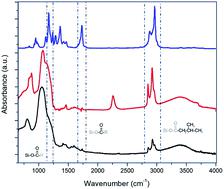当前位置:
X-MOL 学术
›
Faraday Discuss.
›
论文详情
Our official English website, www.x-mol.net, welcomes your feedback! (Note: you will need to create a separate account there.)
The shell matters: one step synthesis of core-shell silicon nanoparticles with room temperature ultranarrow emission linewidth.
Faraday Discussions ( IF 3.4 ) Pub Date : 2019-11-04 , DOI: 10.1039/c9fd00093c Anna Fucikova 1 , Ilya Sychugov , Jan Linnros
Faraday Discussions ( IF 3.4 ) Pub Date : 2019-11-04 , DOI: 10.1039/c9fd00093c Anna Fucikova 1 , Ilya Sychugov , Jan Linnros
Affiliation

|
Here we present a one-step synthesis that provides silicon nanocrystals with a thin shell composed of a ceramic-like carbonyl based compound, embedded in a porous organosilicon film. The silicon nanocrystals were synthesised from hydrogen silsesquioxane molecules, modified with organic molecules containing carbonyl groups, which were annealed at 1000 °C in a slightly reducing 5% H2 : 95% Ar atmosphere. The organic character of the shell was preserved after annealing due to trapping of organic molecules inside the HSQ-derived oxide matrix that forms during the annealing. The individual silicon nanocrystals, studied by single dot spectroscopy, exhibited a significantly narrower emission peak at room temperature (lowest linewidth ∼ 17 meV) compared to silicon nanocrystals embedded in a silicon oxide shell (150 meV). Their emission linewidths are even significantly narrower than those of single CdSe quantum dots (>50 meV). It is hypothesized that the Si-core–thin shell structure of the nanoparticle is responsible for the unique optical properties. Its formation within one synthesis step opens new opportunities for silicon-based quantum dots. The luminescence from the produced nanocrystals covers a broad spectral range from 530–720 nm (1.7–2.3 eV) suggesting strong application potential for solar cells and LEDs, following the development of a suitable mass-fabrication protocol.
中文翻译:

壳很重要:一步合成具有室温超窄发射线宽的核-壳硅纳米粒子。
在这里,我们提出了一种一步合成方法,该方法为硅纳米晶体提供了一个薄壳,该薄壳由嵌入多孔有机硅膜中的类陶瓷羰基化合物构成。硅纳米晶体由氢倍半氧烷分子合成,并用含羰基的有机分子修饰,然后在5%H 2稍微还原的条件下于1000°C退火 :95%Ar气氛。壳的有机特性在退火后得以保留,这是因为在退火过程中形成的HSQ衍生的氧化物基体内捕获了有机分子。通过单点光谱研究的单个硅纳米晶体在室温下(最低线宽约17 meV)与嵌入氧化硅壳(150 meV)中的硅纳米晶体相比,呈现出明显更窄的发射峰。它们的发射线宽甚至比单个CdSe量子点(> 50 meV)的发射线宽更窄。据推测,纳米粒子的硅核-薄壳结构是造成独特光学特性的原因。它在一个合成步骤中形成,为基于硅的量子点带来了新的机遇。
更新日期:2019-11-04
中文翻译:

壳很重要:一步合成具有室温超窄发射线宽的核-壳硅纳米粒子。
在这里,我们提出了一种一步合成方法,该方法为硅纳米晶体提供了一个薄壳,该薄壳由嵌入多孔有机硅膜中的类陶瓷羰基化合物构成。硅纳米晶体由氢倍半氧烷分子合成,并用含羰基的有机分子修饰,然后在5%H 2稍微还原的条件下于1000°C退火 :95%Ar气氛。壳的有机特性在退火后得以保留,这是因为在退火过程中形成的HSQ衍生的氧化物基体内捕获了有机分子。通过单点光谱研究的单个硅纳米晶体在室温下(最低线宽约17 meV)与嵌入氧化硅壳(150 meV)中的硅纳米晶体相比,呈现出明显更窄的发射峰。它们的发射线宽甚至比单个CdSe量子点(> 50 meV)的发射线宽更窄。据推测,纳米粒子的硅核-薄壳结构是造成独特光学特性的原因。它在一个合成步骤中形成,为基于硅的量子点带来了新的机遇。


























 京公网安备 11010802027423号
京公网安备 11010802027423号